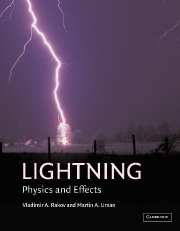Book contents
- Frontmatter
- Contents
- Preface
- 1 Introduction
- 2 Incidence of lightning
- 3 Electrical structure of lightning-producing clouds
- 4 Downward negative lightning discharges to ground
- 5 Positive and bipolar lightning discharges to ground
- 6 Upward lightning initiated by ground-based objects
- 7 Artificial initiation (triggering) of lightning by ground-based activity
- 8 Winter lightning in Japan
- 9 Cloud discharges
- 10 Lightning and airborne vehicles
- 11 Thunder
- 12 Modeling of lightning processes
- 13 The distant lightning electromagnetic environment: atmospherics, Schumann resonances, and whistlers
- 14 Lightning effects in the middle and upper atmosphere
- 15 Lightning effects on the chemistry of the atmosphere
- 16 Extraterrestrial lightning
- 17 Lightning locating systems
- 18 Deleterious effects of lightning and protective techniques
- 19 Lightning hazards to humans and animals
- 20 Ball lightning, bead lightning, and other unusual discharges
- Appendix: Books on lightning and related subjects
- Index
3 - Electrical structure of lightning-producing clouds
Published online by Cambridge University Press: 05 June 2013
- Frontmatter
- Contents
- Preface
- 1 Introduction
- 2 Incidence of lightning
- 3 Electrical structure of lightning-producing clouds
- 4 Downward negative lightning discharges to ground
- 5 Positive and bipolar lightning discharges to ground
- 6 Upward lightning initiated by ground-based objects
- 7 Artificial initiation (triggering) of lightning by ground-based activity
- 8 Winter lightning in Japan
- 9 Cloud discharges
- 10 Lightning and airborne vehicles
- 11 Thunder
- 12 Modeling of lightning processes
- 13 The distant lightning electromagnetic environment: atmospherics, Schumann resonances, and whistlers
- 14 Lightning effects in the middle and upper atmosphere
- 15 Lightning effects on the chemistry of the atmosphere
- 16 Extraterrestrial lightning
- 17 Lightning locating systems
- 18 Deleterious effects of lightning and protective techniques
- 19 Lightning hazards to humans and animals
- 20 Ball lightning, bead lightning, and other unusual discharges
- Appendix: Books on lightning and related subjects
- Index
Summary
The basic difficulty in determining how thunderclouds become electrified lies in the fact that they are large, complex, and short-lived phenomena that need to be examined both as a whole and in detail to understand how they function. The electrical processes are intimately related to the cloud dynamics or motions and to the microphysics of the cloud, namely, to the populations and interactions of the precipitation, cloud droplets, ice crystals, and other particles that make up the cloud.
P. R. Krehbiel (1986)Introduction
The primary source of lightning is the cloud type termed cumulonimbus, commonly referred to as the thundercloud. The term “cumulonimbus cloud” is often used in the literature, although it is redundant. Strictly speaking, not every cumulonimbus produces lightning (e.g., Imyanitov et al. 1971), that is, a thundercloud could be more properly defined as a lightning-producing cumulonimbus. Sometimes the term “thunderstorm” is used as a synonym for thundercloud, although a thunderstorm is usually a system of thunderclouds rather than a single thundercloud. Lightning produced by thunderclouds formed over forest fires or contaminated by smoke is considered in Section 5.2. The electrical properties of clouds other than the cumulonimbus (primarily stratiform clouds) are reviewed in Section 3.3, and further information can be found, for example, in the books by Imyanitov et al. (1971) and by MacGorman and Rust (1998: Chapter 2 and Section 8.4). Lightning-like electrical discharges can also be generated in the ejected material above volcanoes, in sandstorms, and in nuclear explosions (Section 20.7). Clouds on planets other than Earth as potential sources of lightning are discussed in Chapter 16.
- Type
- Chapter
- Information
- LightningPhysics and Effects, pp. 67 - 107Publisher: Cambridge University PressPrint publication year: 2003
- 1
- Cited by



